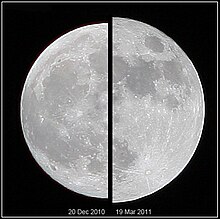Supermoon



A supermoon is the coincidence of a full moon or a new moon with the closest approach the Moon makes to the Earth on its elliptical orbit, resulting in the largest apparent size of the moon's disk as seen from Earth. The technical name is the perigee-syzygy of the Earth-Moon-Sun system. The term "supermoon" is not an astronomical one, but one that originated in modern astrology.[1] The association of the Moon with both oceanic and crustal tides has led to claims that the supermoon phenomenon may be associated with increased risk of events such as earthquakes and volcanic eruptions. However, the evidence of such a link is widely held to be unconvincing.[2]
Definition
The Moon's distance varies each month between approximately 357,000 kilometers (222,000 mi) and 406,000 km (252,000 mi) due to its elliptical orbit around the Earth (distances given are center-to-center).[3][4][5]
According to NASA, a full moon at perigee is up to 14% larger and 30% brighter than one at its furthest point (apogee).[6]
Terminology
The name SuperMoon was coined by astrologer Richard Nolle in 1979, arbitrarily defined as:
...a new or full moon which occurs with the Moon at or near (within 90% of) its closest approach to Earth in a given orbit (perigee). In short, Earth, Moon and Sun are all in a line, with Moon in its nearest approach to Earth.[7]
The term supermoon is not used within the astronomical community, which use the term perigee-syzygy or perigee moon.[8] Perigee is the point at which the Moon is closest in its orbit to the Earth, and syzygy is a full or new moon, when the Earth, the Moon and the Sun are aligned. Hence, a supermoon can be regarded as a combination of the two, although they do not perfectly coincide each time. On average, about once a year the moon becomes full within a few hours of perigee.[8]
Effect on tides
The combined effect of the Sun and Moon on the Earth's oceans, the tide,[9] is greatest when the Moon is either new or full. At lunar perigee the tidal force is somewhat stronger,[10] resulting in perigean spring tides. But even at its most powerful this force is still relatively weak[4] causing tidal differences of inches at most.[11]
As the tidal force follows an inverse-cube law, that force is 18% greater than average. However, because the actual amplitude of tides varies around the world, this may not translate into a direct effect.
It has been claimed that the supermoon of March 19, 2011 was responsible for the grounding of five ships in the Solent in the UK,[12] but such claims are not supported by scientific evidence.
Natural disasters
Certain prognosticators have moved the goalposts to within 1 or 2 weeks of a supermoon to suggest a causal relationship with specific natural disasters such as the 2011 Tōhoku earthquake and tsunami and the 2004 Indian Ocean earthquake and tsunami.[13][14] However in both cases the Moon was actually farther from the Earth than average.[4] No evidence has been found of any correlation with major earthquakes.[15][16][17]
References
- ^ Kryptonite for the supermoon | Bad Astronomy | Discover Magazine
- ^ "No Link Between 'Super Moon' and Earthquakes" at news.discovery.com
- ^ Meeus, Jean (1997). Mathematical Astronomy Morsels. Richmond, Virginia: Willmann-Bell. p. 15. ISBN 0-943396-51-4.
- ^ a b c Plait, Phil (March 11, 2011). "No, the 'supermoon' didn't cause the Japanese earthquake". Discover Magazine. Retrieved 14 March 2011.
- ^ Hawley, John. "Appearance of the Moon Size". Ask a Scientist. Newton. Retrieved 14 March 2011; no publication date.
{{cite web}}: Check date values in:|accessdate=(help) - ^ "Super Full Moon". NASA.
- ^ Nolle, Richard. "Supermoon". Astropro. Retrieved 14 March 2011; no publication date; modified March 10, 2011.
{{cite web}}: Check date values in:|accessdate=(help) - ^ a b Phillips, Tony (May 2, 2012). "Perigee "Super Moon" On May 5-6". NASA Science News. NASA. Retrieved 6 May 2012.
- ^ Plait, Phil (2008). "Tides, the Earth, the Moon, and why our days are getting longer". Bad Astronomy. Retrieved 14 March 2011; modified March 5, 2011.
{{cite web}}: Check date values in:|accessdate=(help) - ^ "Apogee and Perigee of the Moon". Moon Connection. Retrieved 14 March 2011; no publication date.
{{cite web}}: Check date values in:|accessdate=(help) - ^ Rice, Tony (4 May 2012). "Super moon looms Saturday". WRAL-TV. Retrieved 5 May 2012.
- ^ Supermoon blamed for stranding five ships in Solent” at.telegraph.co.uk, retrieved 23 March 2011
- ^ Paquette, Mark (March 1, 2011). "Extreme Super (Full) Moon to Cause Chaos?". Astronomy Weather Blog. AccuWeather. Retrieved 14 March 2011;.
{{cite web}}: Check date values in:|accessdate=(help)CS1 maint: extra punctuation (link) - ^ "Is the Japanese earthquake the latest natural disaster to have been caused by a supermoon?". The Daily Mail. March 11, 2011. Retrieved 14 March 2011.
- ^ "Can the position of the Moon affect seismicity?". The Berkeley Seismological Laboratory. 1999. Retrieved 14 March 2011.
- ^ Fuis, Gary. "Can the position of the moon or the planets affect seismicity?". U.S. Geological Survey: Earthquake Hazards Program. Retrieved 14 March 2011; no publication date.
{{cite web}}: Check date values in:|accessdate=(help) - ^ Wolchover, Natalie (March 9, 2011). "Will the March 19 "SuperMoon" Trigger Natural Disasters?". Life's Little Mysteries. Retrieved 15 March 2011.

